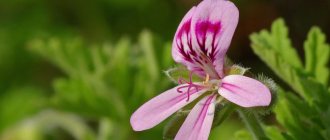Sapling bushes, a perennial herbaceous plant from the Asteraceae family, growing in European and Asian territories, northern America and the tropics of Africa, are decorative not only during long flowering. Throughout the season, they look original in the garden plot, on the lawn, in compositions with cereals, perennial crops, flowers, and perfectly decorate ponds. An unpretentious and hardy sable flower will attract attention both in single and group plantings.
Description and distinctive features
The appearance of the window sill depends on the species and variety. In the general description, one can identify features characteristic of most species. Under natural conditions, it is either a low (30 cm) or tall subshrub, up to 2 m high.
A distinctive feature is straight, weakly branching stems and petiolate oppositely attached leaves, which can be pinnate, palmate-lobed, lanceolate, or ovate. The edge of the plate is cut with small teeth. The color of the smooth or rough leaf is mainly dark shades of green; some species have pronounced burgundy veins and dark purple streaks.
In August, fragrant inflorescences appear, formed by small cream, white or purple flowers, collected in a small basket. Sometimes the width of the inflorescence reaches a quarter of a meter. The flower petals are round, the stamens are collected in a bunch. Flowering is abundant and long lasting until late autumn.
The scientific name (Eupatorium) of the flower was given in memory of Mithridates Eupator (Kingdom of Pontus), who used one of the varieties as an antidote. According to one version, the origin of the Russian name is associated with its similarity to the male hemp plant, which was colloquially called “poskon”.
General information about the plant
The sapling plant is a herbaceous perennial. It belongs to the Asteraceae family. In the wild, the plant grows in Europe, Asia, northern Africa, and also on the coast of America.
The window sill is not afraid of frost, so it easily adapts to the climate of the middle zone. Externally, the plant is a tall bushy grass. The stem can reach 2 m in height. It is usually covered with villi and hollow inside. The leaves are large, pointed, with jagged edges, and dark green.
The plant has noticeable flowering. The buds are collected in baskets that form dense clusters. The color of the corollas varies from white-pink to purple. Flowering continues for up to a couple of months, starting in early July.
Poskonnik - how to grow in open ground
You can grow saplings from rhizomes or stratified seeds. Stratification is simple - mix the seeds with wet sand, pour them into a glass container and place them in the vegetable section of the refrigerator for a month.
When purchasing a rhizome, you need to inspect it, paying attention to elasticity, density, absence of putrefactive spots and damage. If it is purchased in the spring, then it should have buds. The seedling of the finished seedling should have a dense stem and leaves, the roots should not stick out from the container (if they are visible, it means the seedling is overexposed and weakened). Be sure to inspect the rhizome and young plants for the presence of insects and fungal infections.
Sowing seedlings
You need to sow seeds in the ground in the first ten days of March, using ready-made soil for flower crops. The planting depth should be no more than 5 mm so as not to impede germination. Cover the container with cellophane (glass) and place in a warm, bright place, but not in direct sunlight. The greenhouse must be ventilated to remove condensation, moisten the soil without allowing the top layer to dry out.
Soak the seeds for 24 hours in a pink manganese solution.
After 2-3 weeks, shoots will appear; after that, remove the cover. When two pairs of leaves are formed, pick into separate containers. 10-12 days before planting in open ground, begin hardening by taking the seedlings outside and gradually increasing the time of the procedure. Purchased seedlings must also be hardened.
Selecting a location and planting in the ground
The culture is distinguished by its undemandingness to light - the window sapling grows well in sunny areas and in partial shade. It also blooms in the shade, but you need to keep in mind that the flowers and leaves will be smaller. There are also no special requirements for the composition of the soil, but on heavy soils it loses its decorative effect, so they can be lightened by adding sand and peat.
Seedlings are planted in a permanent place when the soil is warmed up and there is no threat of return frosts - in the 2nd-3rd decade of May.
Before planting seedlings, the area needs to be dug up; you can add 3-5 kg/1 m² of compost. Make holes at a distance of 60-80 cm from each other, their depth should correspond to the size of the root system. Water the plantings and cover them from the sun for several days so that rooting occurs faster and with the least stress for the plants.
How to care
Caring for window sills in open ground is not difficult. Like any plant, it needs feeding, watering, weeding, loosening, pruning, and protection from insects. The crop is distinguished by its high growth, so you should provide for the installation of a support or plant the flower near a fence or buildings so that there are no through winds that could break the stems. The stems are not pruned, but in order to preserve decorativeness and prevent self-seeding, faded inflorescences are cut off.
The plant is cold-resistant, so there is no need to cover it for the winter - it is enough to cut off the above-ground part at the end of autumn.
Watering, fertilizing
As a moisture-loving crop, the flower needs to be watered regularly, depending on the weather conditions. It is important to prevent the soil from drying out and flooding. Loosening will eliminate the formation of crust on the surface and the growth of weeds. Mulch made from grass, leaves, hay will reduce moisture loss and inhibit the growth of weeds; crushed dry branches, small pebbles, pine cones, and decorative bark can be used to give a decorative look. Humus and compost as mulch will become a source of additional nutrition.
The choice of fertilizer for the sill is influenced by the period of its application. In the spring, when feeding for the first time, it is recommended to use complexes with a prevailing nitrogen content - it stimulates the growth of green mass, which is important for an ornamental plant. Watering with mullein infusion and adding humus to the soil gives a good effect.
They feed the second time in June, enriching the soil with macro- and microelements necessary for the formation of buds and abundant flowering. Complex fertilizers for flowering crops are suitable - they indicate the composition and exact dosage. You can add phosphorus, potassium, magnesium, nitrogen separately, following the instructions.
The next feeding is carried out during the budding period, using complexes with potassium: potassium salt, potassium sulfate, nitrate, potassium chloride.
Nitrogen is not needed during this period - the plant’s forces should be directed to the formation and development of buds, and nitrogen causes foliage to grow.
In mid-October, phosphorus-potassium complexes with a minimal content (or complete absence) of nitrogen are introduced to support the immunity of the perennial before the winter cold. They can be used dry or in solution. Humus and compost poured under each bush will protect the roots in frosts and replenish the soil with organic matter.
Pests, diseases
The culture has good immunity and is not susceptible to pests or infections. It can be harmed by the larvae of moths, insects, beetles - the so-called miners, which eat passages in the stems and leaves. Pruning the affected parts and treating the entire plant with an insecticide helps.
More details about window sill care in the video:
Where is it used?
The purpose of planting a window sill is usually to decorate the area. It is often used to decorate buildings and fences. It is suitable for creating flower beds with tall plants or mixes.
The window sill looks accentuated against the background of tall and dense thickets: trees, shrubs. Dense plantings are often created with it. This plant will be a wonderful decoration for water bodies.
For proximity to the window sill they prefer to use:
- loosestrife;
- sagebrush;
- Japanese anemone.
The flowers of the plant emit a pleasant aroma, attracting various insects. This technique is often used by those who seek to pollinate useful crops or collect honey. Pokonnik is also considered a medicinal plant. It is used in folk medicine.
Reproduction methods
The saplings are propagated by divisions, shoots, and cuttings.
Delenkoy
You can get a division only from an adult (4-5 years old) plant in spring or early autumn. Planting in the spring will allow the flower to grow stronger before the onset of cold weather.
Before digging up the bush, the shoots are cut off, leaving “stumps” 20 cm high, and the soil is moistened. The rhizomes, freed from the ground, are divided (you can use a saw) into parts, the sections are treated with a fungicide and planted in a permanent place in holes prepared in advance.
There must be growth points (at least three) on the division.
By shoots
The use of shoots presupposes the presence of recovery buds. In the spring, when the shoots grow to 5 cm, they are cut out along with the rhizome. Each bud is planted in a separate cup or in a common container, maintaining an interval of 7 cm between them. The seedlings are placed in a warm, shaded place and watered moderately. After rooting, after about 4 weeks, they are transplanted into a flower bed.
Handle
Cuttings are carried out at the end of June, the length of the cuttings should be 10-15 cm, there should be three or more growth points. For rooting, they are planted in a damp mixture of peat and sand, covered with a jar (bag). Care consists of ventilating the greenhouse and moistening the soil. When strong roots appear, after about a month, they are planted in a permanent place.
If you follow the rules for planting and caring for the window sill in the open ground, you can grow a strong, healthy plant with excellent decorative qualities. The perennial will decorate the local area, flower bed, garden plot, lawn, requiring a minimum of attention in return.











